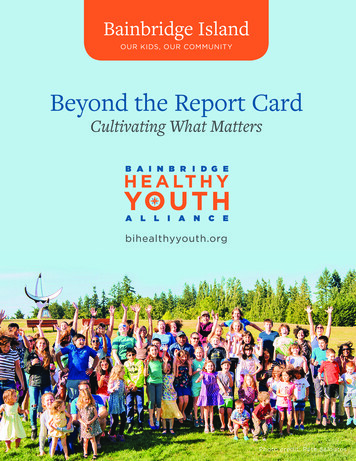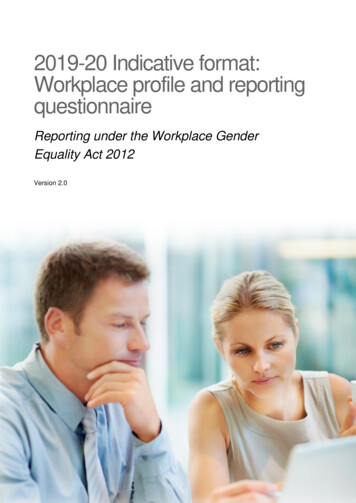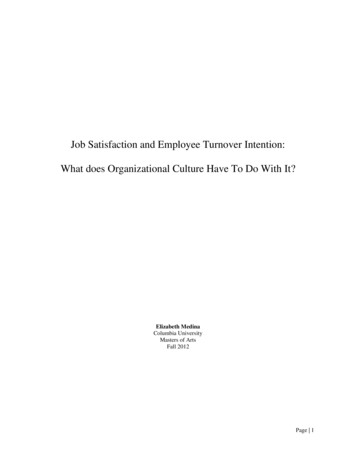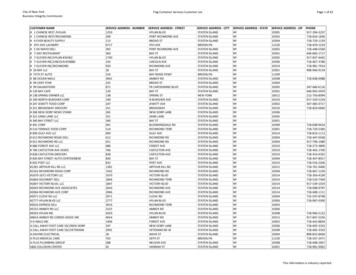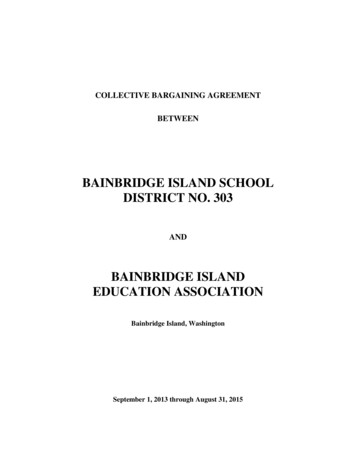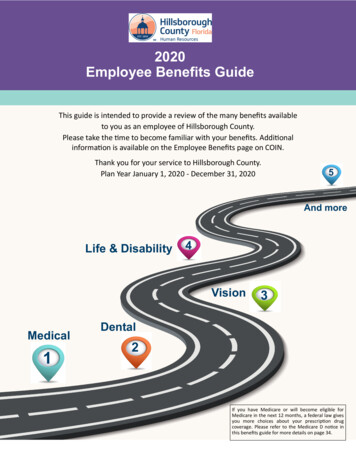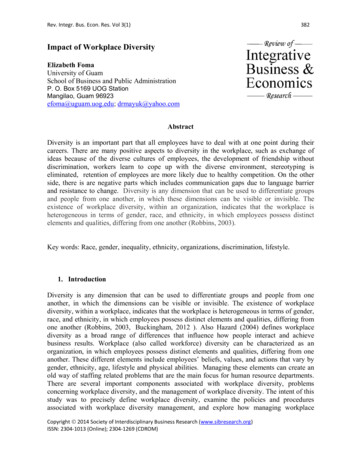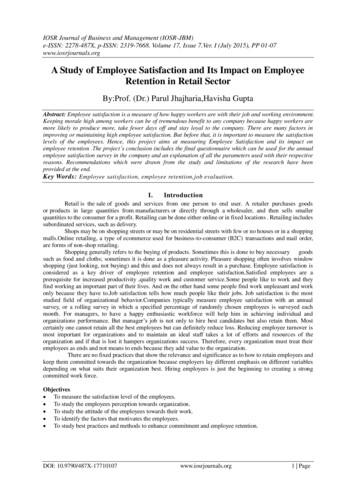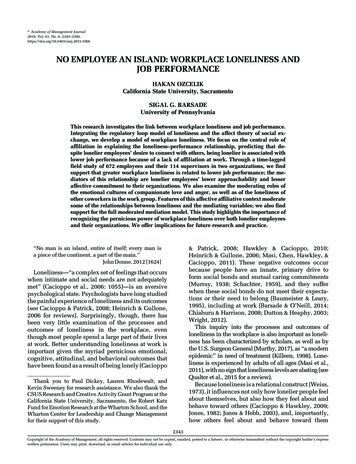
Transcription
r Academy of Management Journal2018, Vol. 61, No. 6, O EMPLOYEE AN ISLAND: WORKPLACE LONELINESS ANDJOB PERFORMANCEHAKAN OZCELIKCalifornia State University, SacramentoSIGAL G. BARSADEUniversity of PennsylvaniaThis research investigates the link between workplace loneliness and job performance.Integrating the regulatory loop model of loneliness and the affect theory of social exchange, we develop a model of workplace loneliness. We focus on the central role ofaffiliation in explaining the loneliness–performance relationship, predicting that despite lonelier employees’ desire to connect with others, being lonelier is associated withlower job performance because of a lack of affiliation at work. Through a time-laggedfield study of 672 employees and their 114 supervisors in two organizations, we findsupport that greater workplace loneliness is related to lower job performance; the mediators of this relationship are lonelier employees’ lower approachability and lesseraffective commitment to their organizations. We also examine the moderating roles ofthe emotional cultures of companionate love and anger, as well as of the loneliness ofother coworkers in the work group. Features of this affective affiliative context moderatesome of the relationships between loneliness and the mediating variables; we also findsupport for the full moderated mediation model. This study highlights the importance ofrecognizing the pernicious power of workplace loneliness over both lonelier employeesand their organizations. We offer implications for future research and practice.“No man is an island, entire of itself; every man isa piece of the continent, a part of the main.”John Donne, 2012 [1624]& Patrick, 2008; Hawkley & Cacioppo, 2010;Heinrich & Gullone, 2006; Masi, Chen, Hawkley, &Cacioppo, 2011). These negative outcomes occurbecause people have an innate, primary drive toform social bonds and mutual caring commitments(Murray, 1938; Schachter, 1959), and they sufferwhen these social bonds do not meet their expectations or their need to belong (Baumeister & Leary,1995), including at work (Barsade & O’Neill, 2014;Chiaburu & Harrison, 2008; Dutton & Heaphy, 2003;Wright, 2012).This inquiry into the processes and outcomes ofloneliness in the workplace is also important as loneliness has been characterized by scholars, as well as bythe U.S. Surgeon General (Murthy, 2017), as “a modernepidemic” in need of treatment (Killeen, 1998). Loneliness is experienced by adults of all ages (Masi et al.,2011), with no sign that loneliness levels are abating (seeQualter et al., 2015 for a review).Because loneliness is a relational construct (Weiss,1973), it influences not only how lonelier people feelabout themselves, but also how they feel about andbehave toward others (Cacioppo & Hawkley, 2009;Jones, 1982; Jones & Hebb, 2003), and, importantly,how others feel about and behave toward themLoneliness—“a complex set of feelings that occurswhen intimate and social needs are not adequatelymet” (Cacioppo et al., 2006: 1055)—is an aversivepsychological state. Psychologists have long studiedthe painful experience of loneliness and its outcomes(see Cacioppo & Patrick, 2008; Heinrich & Gullone,2006 for reviews). Surprisingly, though, there hasbeen very little examination of the processes andoutcomes of loneliness in the workplace, eventhough most people spend a large part of their livesat work. Better understanding loneliness at work isimportant given the myriad pernicious emotional,cognitive, attitudinal, and behavioral outcomes thathave been found as a result of being lonely (CacioppoThank you to Paul Dickey, Lauren Rhodewalt, andKevin Sweeney for research assistance. We also thank theCSUS Research and Creative Activity Grant Program at theCalifornia State University, Sacramento, the Robert KatzFund for Emotion Research at the Wharton School, and theWharton Center for Leadership and Change Managementfor their support of this study.2343Copyright of the Academy of Management, all rights reserved. Contents may not be copied, emailed, posted to a listserv, or otherwise transmitted without the copyright holder’s expresswritten permission. Users may print, download, or email articles for individual use only.
2344Academy of Management JournalDecember(Heinrich & Gullone, 2006). That broader impactmakes loneliness particularly relevant to examine atwork, since connection with others has been found tobe an inherent part of employee motivation and satisfaction (Dutton & Heaphy, 2003). Indeed, we knowfrom some of the earliest field studies in managementthat employees are driven not only by economicneeds but also by the need to establish relationshipsand social attachments (Gouldner, 1954; Mayo, 1949).Given the pervasive and pernicious influence ofloneliness in other life domains, and given how muchtime employees spend at work with each other, theinvestigation of workplace loneliness is important.To better understand the relationship betweenworkplace loneliness and employee attitudes, behavior, and performance, and to build our model ofworkplace loneliness, we draw from two theoreticaltraditions. The first comes from the nearly 40 years ofpsychological research tying greater loneliness tolowered affiliation (e.g., Cacioppo & Patrick, 2008;Heinrich & Gullone, 2006 for reviews), specificallyCacioppo and Hawkley’s (2009) regulatory loopmodel of loneliness, which describes the psychological mechanisms within lonelier people. Thesecond is the affect theory of social exchange(Lawler, 2001, 2006; Lawler & Thye, 2007), a sociological theory that takes into account the role of otherpeople’s thoughts about the lonely person. We integrate these theories to build and empirically testa model of workplace loneliness that helps explainwhy lonelier employees are less affiliative—and whythat lack of affiliation relates to poorer job performance.Through this process, we aim to extend our knowledgein three domains. First, by improving our knowledgeabout loneliness in organizational settings, we aim tocontribute to a more nuanced understanding of howaffect is related to job performance (Elfenbein, 2007),and address the call for greater study of the outcomes ofdiscrete affect at work (Barsade & Gibson, 2007). Second, because of the relational nature of loneliness, weadd to the emerging theorizing about relational systems at work (Dutton & Heaphy, 2003; Grant & Parker,2009) by better understanding how an employee’s relational environments can include feelings of lack ofaffiliation and disconnection. Last, we contribute to theloneliness literatures in psychology and sociology byexpanding our understanding of this powerful socialemotion to the workplace context.& Anderson, 1982). According to affective prototypetheory, each type of discrete affect is determined bya cluster, or prototype, of features that distinguish it.These features include all aspects of the affectiveexperience: feeling states, physiological markers,and cognitive and behavioral categories (Shaver,Schwartz, Kirson, & O’Connor, 1987). The affectiveprototype model is broad enough to encompass affect as a state (including emotions and moods), a trait(dispositional affect), or a sentiment (evaluative affective responses to social objects)—all dependingon the specific affect’s intensity, duration, specificity, and evaluative focus (Barsade & Gibson, 2007).Loneliness, similar to other types of affect,1 has beencharacterized as a state and a sentiment, but is generally not thought of as a trait (although it can bechronic) (Peplau & Perlman, 1982; Spitzberg & Hurt,1989). The prototype model of loneliness also comports with the most cited definition of loneliness,which requires three key components: (1) an unpleasant and aversive feeling, (2) generated from asubjective negative assessment of one’s overall relationships in a particular social domain, and (3)a belief that these social relationships are deficient(Peplau & Perlman, 1982). Defining lonelinessthrough this affective prototype lens, we take intoconsideration the feelings loneliness arouses, thecognitions that comprise it, and the behaviors itevokes.Because loneliness is a subjective experience, anemployee does not have to be alone to feel lonely,and lonely employees can be lonely even wheninteracting frequently with many others if these interactions do not provide lonelier employees withtheir desired level of closeness (Fischer & Phillips,1982). Whether employees feel lonely depends onthe level of closeness, security, and support they seekin their interpersonal relationships (Jones & Hebb,2003). Thus, the same work environment could fulfill the interpersonal needs of some employees whileleaving other employees lonely.THE NATURE OF LONELINESSWe intentionally use the term “affect” as an “umbrellaterm encompassing a broad range of feelings that individuals experience,” including discrete emotions andgeneralized mood (Barsade & Gibson, 2007: 37).We take an affective prototype approach to loneliness (Heinrich & Gullone, 2006; Horowitz, French,Distinguishing Loneliness from Related ConstructsWe differentiate workplace loneliness from related constructs such as workplace ostracism, whichis an employee’s perception that she or he is beingintentionally excluded or ignored by others at work1
2018Ozcelik and Barsade(Ferris, Brown, Berry, & Lian, 2008). Ostracism differs from loneliness, the subjective nature of whichmakes it possible for two equally ostracized employees to feel different levels of loneliness—and foremployees to feel lonely without being ostracized atall. Empirical research examining these constructstogether has found moderated relationships betweenthe two (Wesselmann, Wirth, Mroczek, & Williams,2012), and ostracism by others has been discussed asan antecedent to loneliness (Leary, 1990), but loneliness and ostracism have not been found eithertheoretically or empirically to be the same construct(Wesselmann et al., 2012; Williams, 2007).Loneliness is also neither a form of depression nora personality trait. Cacioppo and Patrick (2008) offered compelling evidence that although loneliness isrelated to these constructs (and loneliness predictsdepression [Nolen-Hoeksema & Ahrens, 2002]), conceptions of loneliness as a form of depression, shyness, or poor social skills are inaccurate (Anderson& Harvey, 1988; Hawkley, Burleson, Berntson, &Cacioppo, 2003; Hawkley & Cacioppo, 2010). Thereis also much evidence across myriad studies thatloneliness is not a disposition, and differs from personality traits such as negative affectivity, introversion, and disagreeableness (e.g., Cacioppo et al., 2006;Russell, Peplau, & Cutrona, 1980). Last, lonelinessdiffers from solitude (Heinrich & Gullone, 2006),which, contrary to loneliness, is a pleasant, desirableand freely chosen state (Derlega & Margulis, 1982).WORKPLACE LONELINESS: ACONCEPTUAL MODELLoneliness researchers have found that peopleexperience different levels of loneliness in differentdomains of their lives, such as family life, the romantic realm, and the social domain (DiTommaso &Spinner, 1993). In line with this research, we focusspecifically on the workplace domain, and conceptualize degree of workplace loneliness as employees’subjective affective evaluations of, and feelingsabout, whether their affiliation needs are being metby the people they work with and the organizationthey work for.Affiliation, a central influence on human behavior (Hill, 1987), is the degree to which people haveclose interpersonal bonds, harmonious relationships,and a sense of communion with others (Depue &Morrone-Strupinsky, 2005; Mehrabian & Ksionzky,1974; Murray, 1938). Motivated by the desire forsocial contact and belongingness (Murray, 1938;Schachter, 1959), affiliation is a key component of2345social interactions (Hess, 2006; Mehrabian & Ksionzky,1974) and largely explains how loneliness influences life outcomes (Weiss, 1973). Affiliation manifests in two major ways: through attitudes andbehaviors. Affiliative attitudes reflect how close andattached people feel to their social environments(Freeman, 1992), which, within the work context,we operationalize as employees’ affective commitment to the organization (Allen & Meyer, 1990).Affiliative behaviors manifest in people’s behavioral expressions of attachment and involvement insocial interactions, particularly those expressionsthat indicate closeness (Mehrabian & Ksionzky,1974). Inherent to the behavioral manifestation ofaffiliation is having others perceive you as being approachable, both verbally and nonverbally (Mehrabian& Ksionzky, 1974; Wiemann, 1977). Therefore, in thework context, we operationalize affiliative behaviors as an employee’s affiliative approachability toward coworkers (which we refer to as “employeeapproachability” for conciseness).We hypothesize that the workplace loneliness–affiliation relationship is related to work outcomes.Because loneliness arises from a person’s basicneed to belong to a social environment in which heor she feels psychologically secure and protected(Baumeister & Leary, 1995), it can be adaptive byincreasing the lonely person’s motivation to build orrebuild affiliations—but only if experienced as a shortlived emotion (Cacioppo et al., 2006; Qualter et al.,2015), such as feeling lonely for an afternoon, or inthe first days of starting a new job. However, one ofthe most robust findings in the loneliness literature(e.g., Cacioppo & Patrick, 2008; Heinrich & Gullone,2006; Jones & Hebb, 2003; Qualter et al., 2015) isthat when loneliness becomes a more establishedsentiment—that is, a valenced assessment and comprising feelings about a particular group or interpersonal setting (Frijda, 1994)—it actually has theopposite effect, impeding the satisfaction of belongingness needs “through faulty or dysfunctional cognitions, emotions, and behaviors” (Heinrich & Gullone,2006: 698). This occurs when people come to believethat the meaningful social connections they want arenot available; their fear, hypervigilance, and subjectivefeelings of rejection cause them to withdraw and giveup on building the very interpersonal relationshipsthey crave (Masi et al., 2011).Theoretical FrameworkBy combining these two theories relevant toour questions about workplace loneliness—the
2346Academy of Management Journalpsychologically oriented regulatory loop model(Cacioppo & Hawkley, 2009) and the interpersonallyand contextually oriented affect theory of social exchange (Lawler, 2001)—we build a model of workplace loneliness showing that greater workplaceloneliness predicts lower job performance, as mediated by lower employee affiliation (both attitudinaland behavioral). In addition, we predict that two situational factors moderate the relationship betweenworkplace loneliness and lowered affiliation: theemotional culture of the employee’s work group(culture of anger and culture of companionate love)and the aggregate loneliness of other employees in theemployee’s work group. We elaborate upon ourmodel of workplace loneliness below (see Figure 1).Regulatory loop model of loneliness. In theirregulatory loop model of loneliness, Cacioppo andHawkley (2009) showed that once people have madethe evaluation that their relational needs are notbeing met, and that a particular context makesthem feel lonely, they develop an acute need to feelpsychologically protected and secure. This makeslonelier people more vigilant and defensive aboutDecemberinterpersonal relationships, prompting them to continually appraise situations to see whether theserelationships can meet their belongingness needsand alleviate their loneliness (Weiss, 1973). Because loneliness is often accompanied by a “perceptionthat one is socially on the edge and isolated from others”(Cacioppo, Grippo, London, Goessens, & Cacioppo,2015: 243), lonelier people are overly vigilant to socialthreats, although not to other types of threat (Cacioppo,Balogh, & Cacioppo, 2015; Cacioppo, Bangee, Balogh,Cardenas-Iniguez, Qualter, & Cacioppo, 2016). This social hypervigilance leads them to fall prey to sociallybased attentional, confirmatory, and memory biases, allof which induce them to view their “social world asthreatening and punitive” (Cacioppo & Hawkley, 2009:451). As a result, lonelier people become less secure insocial interactions (Hawkley et al., 2003) and moreanxious about being negatively evaluated by others(Cacioppo et al., 2006; Cacioppo & Patrick, 2008;Jones, 1982). This socially anxious state leadslonelier people to be more likely to engage in inappropriate self-disclosure patterns (Jones, Hobbs,& Hockenbury, 1982) and to show other deficits inFIGURE 1Conceptual Model of Workplace LonelinessCulture ofCompanionateLove(Work Group)Culture ofAnger(Work Group)EmployeeApproachability(Coworker Ratings)WorkplaceLoneliness(Self-Report)Job Performance(Supervisor Ratings)Loneliness ofEmployee’sCoworkers(Coworker Ratings)Employee AffectiveCommitmentto the Organization(Self-Report)
2018Ozcelik and Barsadesocial skills (Bell, 1985; Russell et al., 1980) that undermine their social interactions by eliciting more negative feelings, displays, and behaviors on the part ofothers (see Heinrich & Gullone, 2006 for a review).In short, loneliness can create a hard-to-break cycleof negative social interactions, whereby greater loneliness causes more intrapsychic negative attributionsabout others, which prompt awkward or negative behaviors that actually breed less affiliation (Masi et al.,2011), which in turn gets reciprocated in kind(Mehrabian & Ksionzky, 1974; Perlman & Peplau,1981). Thus, the people who most need to build securerelationships have the most trouble doing so (Rokach,1989).2 The memoirist Emily White (2010: 161) described the bitter irony of this loneliness cycle at work:Out of everyone [in the group], I was probably the onewho needed sociability the most. . . Yet when confronted with [others] who wanted to get close to me,I retreated into a stiff and stammering version of myself, and became oddly resentful of the people whowere trying to befriend me. . . [M]y loneliness was altering my behavior and my perceptions of others.Although the regulatory loop model of lonelinessdoes an excellent job of explaining the maladaptivepsychological motivations of lonely employees, thismodel alone is not enough to predict the effects ofworkplace loneliness on job performance. This isbecause it does not focus on the interpersonal natureof work—that is, the expectations that employeeshave of each other in their workplace interactions.The regulatory loop model also does not explain howthe lack of affiliation employees feel toward theirwork group extends to a lowered commitment to thelarger organization. To fill these gaps, we turn to theaffect theory of social exchange, which providesa more interpersonally and contextually orientedlens through which to understand the affiliative andperformance outcomes of loneliness within the social context of organizations.Affect theory of social exchange. Lawler’s (2001)affect theory of social exchange “explains how andwhen emotions produced by social exchange generate stronger or weaker ties to relations, groups,or networks” (321). The theory posits that social2Research has found that the reason why lonely peoplecannot get themselves out of this negative regulatory loophas to do with their attributions. They feel unable to changetheir situation because they attribute their loneliness toperceived lack of control, which leads to lower expectations of success and thus lower motivation to engage (seeHeinrich & Gullone, 2006 for a review of this literature).2347exchanges between people produce positive ornegative feelings (Lawler & Thye, 1999), which individuals in the exchange consider either intrinsically rewarding or punishing (Lawler, 2001; Lawler& Thye, 2007). The global feelings arising from thesesocial exchanges then trigger cognitive attributionalefforts to understand the sources or causes of thesefeelings, and these attributions influence how people assess their relations with specific others (suchas members of their work team), as well as withtheir broader group (their organization as a whole)(Lawler, Thye, & Yoon, 2008). When negative feelings predominate, therefore, people decide thatcertain relationships are not worth the effort, andthis decision fans out to ever-widening circles ofpotential connections.All of this occurs through the process of affiliation(or disaffiliation), and affiliation in turn predictsprosocial behavior. Positive feelings experienced bya person from interactions with others within thegroup will be related to stronger affiliative attachments to the individuals in the group and organization, leading to a greater exchange of affective andhelping resources (Lawler, Thye, & Yoon, 2014).Conversely, negative feelings, such as greater loneliness, will be related to weaker attachments, lessaffiliation (Lawler, 2006), and less exchange of affective and other help. The affect theory of socialexchange shares with the regulatory loop model ofloneliness the notion that affiliation (or its absence)is the key process resulting from an evaluation ofone’s social connections, and thus influences thequality of a lonely person’s relationships. However,the affect theory of social exchange goes further byanalyzing these feelings in a broader interpersonalcontext. This broader context is especially important in building a workplace model of lonelinessbecause workplaces depend heavily on interpersonal exchange relationships. By considering therole of a lonely worker’s coworkers, the affect theoryof social exchange helps us make better predictionsabout the relationship between loneliness and jobperformance. In particular, this theory reinforces therole of affiliation, which also helps to explain whycoworkers notice and care that their lonelier colleagues are less approachable, and why less approachability relates to lonelier employees’ loweredjob performance. Furthermore, by considering attributional processes, the affect model of social exchange (unlike the regulatory loop model) helpsexplain why the lower affiliation lonelier employeesfeel toward their immediate coworkers extends tolower affective commitment to the organization as
2348Academy of Management Journala whole. Below, we elaborate on how each of theprocesses above is uniquely explained by the affecttheory of social exchange, by the regulatory loopmodel, and by the complementary predictions madeby both models.Greater Employee Workplace Loneliness Relatedto Lower Employee ApproachabilityThe affect theory of social exchange argues thatdepending on their expected outcomes in a possibleexchange relationship, people make decisions aboutwhether to exchange, with whom, and under whatconditions (Lawler, 2001). As the regulatory loopmodel of loneliness (Cacioppo & Hawkley, 2009)highlights at the psychological level, employees experiencing greater work loneliness will likely evaluate their previous social exchanges with coworkersas negative (“When we get together, I feel bad”);therefore, lonelier employees will tend to withdrawfrom existing relationship opportunities. In addition, lonelier employees will expect the worst in thefuture, causing them to continue to withdraw—atendency exacerbated by deficits in their social skillscaused by the loneliness itself (Bell, 1985; Russellet al., 1980). For example, lonelier people have beenfound to have more problems in taking part ingroups, being friendly, introducing themselves, andmaking friends with others (Horowitz & French,1979). This is despite the fact that lonelier people donot have inferior social skills to begin with (Cacioppo& Hawkley, 2005). Rather, as they become lonelier,their preoccupation with their own feelings can leadto deficits in empathy for others (Jones et al., 1982),impeding their capacity to connect successfully andto be perceived as affiliatively approachable (Bell,1985; Mehrabian & Ksionzky, 1974). For example,lonelier people have been found to respond moreslowly to conversation partners, ask fewer questions,and focus more on themselves compared to lesslonely people (Jones et al., 1982).Because of the importance of affiliation as a majorresource exchanged in social relationships (Foa &Foa, 1974), people are quite accurate in perceiving,recording, and recalling other people’s affiliativepatterns in their social environment (Freeman,1992). For example, people continually evaluatethe level of affiliation they maintain with others intheir social interactions by paying close attention tothe verbal and nonverbal cues they receive (Miles,2009). Therefore, our model predicts that whenlonelier employees show a lack of affiliative behaviors, their coworkers take notice. Specifically, theyDecemberperceive lonelier employees as less affiliativelyapproachable—less available for close interpersonalwork bonds, personal communion with others, andharmonious relationships.Hypothesis 1. Employees who experience higherlevels of workplace loneliness will be less affiliativelyapproachable toward their coworkers (employeeapproachability).Greater Workplace Loneliness and ReducedAffective Commitment to the OrganizationAffective commitment refers to an employee’s affiliation with, emotional attachment to, identification with, and involvement in his or her organizationthrough feelings (such as belongingness, affection,and warmth) that lead to a rewarding work experience (Meyer & Allen, 1997). We predict that employees who experience loneliness in their workgroups will reduce their affective commitment to theorganization for both psychological and interpersonal reasons.As predicted by the regulatory loop model ofloneliness, the social hypervigilance of lonelierpeople (Cacioppo & Hawkley, 2009) leads to theiraffective and attitudinal withdrawal from thegroups of which they are a part. The attributionalprocesses described by the affect theory of socialexchange explain how this group-level reduction inaffective commitment leads to a reduction in affective commitment to the organization as a whole.Specifically, people generalize from their smallerdyadic or group-level exchanges to the broadergroup (Lawler, 2001; Lawler & Yoon, 1996). Because the feelings that arise from social exchangestrigger cognitive efforts to understand the sourcesor causes of these feelings, people tend to interpretand explain these feelings with reference to thelarger social units in which they are embedded,such as an organization (Lawler, 2006). As a resultof being lonely in their work group, lonelier employees assume that the probability of a positiveexchange with others across the organization is alsolower, and will project the responsibility for theircurrent loneliness onto the broader organization.This attribution leads them to be less willing to invest themselves emotionally, and thus to lowertheir affective commitment to the organization asa whole (Lawler, 2001).Hypothesis 2. Employees who experience higherlevels of workplace loneliness will be less affectivelycommitted to their organization.
2018Ozcelik and BarsadeGreater Workplace Loneliness and ReducedEmployee Performance: The Mediating Role ofEmployee Approachability and Employee AffectiveCommitment to the OrganizationWe predict that lower employee approachabilitywill negatively relate to the employee’s job performance. A growing stream of research has shownthat employee job performance is significantly tiedto an employee’s ability to build and maintain a relational support system and interpersonal networks(Chiaburu & Harrison, 2008; Grant & Parker, 2009;Kahn, 2007). The regulatory loop model of loneliness predicts that lonelier employees are less approachable; the affect theory of social exchangepredicts that coworkers will notice this loweredlevel of approachability as a deficit in the exchangerelationship, and that they will withdraw in response (Lawler et al., 2014). Indeed, lonely behaviorevokes negative social responses in others (Perlman& Peplau, 1981) and less interest in future interactions from others (Bell, 1985), who view lonelierpeople as harder to get to know. This reciprocalprocess impairs the normal development of socialrelationships (Solano, Batten, & Parish, 1982). Yetthe exchange of interpersonal resources in workteams (Seers, 1989) has been found to positively influence performance outcomes by enabling employees to receive more guidance and emotionalsupport (Liden, Wayne, & Sparrowe, 2000), greaterhelp with the work itself (Kamdar & Van Dyne, 2007),engagement in better communication, coordination,and balance of team member contributions (Hoegl &Gemuenden, 2001), greater usage of teammates’ resources and task information (Farh, Lanaj, & Ilies,2017), and better opportunities to develop creativeideas (Grant & Berry, 2011). Therefore, we predictthat lonelier employees’ lower approachability reduces the ability of these employees to receive relational and task resources from their coworkers,thus harming their job performance.Hypothesis 3. Employees who are lonelier at work willhave poorer job performance, as partially mediated bytheir lower approachability towards their coworkers.We also hypothesize that lonelier employees willbe less likely to perform effectively because of theirreduced affective commitment to the organization.As suggested by the regulatory loop model of loneliness (Cacioppo & Hawkley, 2009), the cycle ofnegative social interactions experienced by lonelieremployees will fuel their sense that their work environment is not meeting their relational needs. This2349appraisal, according to the affect theory of socialexchange (Lawler et al., 2008), will lead lonelieremployees to attribute their negative feelings to theiroverall organization; thus, the impaired social exchange relationship between an employee and hisor her organization relates to a withdrawal of support and effort from the employee (Van Dyne, Graha
Loneliness is also neither a form of depression nor a personality trait. Cacioppo and Patrick (2008) of- . opposite effect, impeding the satisfaction of belong-ingness needs “through faulty or dysfunctional cogni


